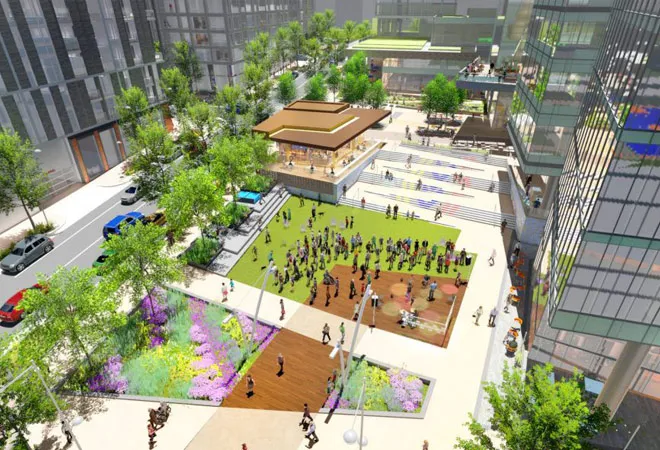
With cities struggling to accommodate their growing populations worldwide, it is ironic that urban agglomerations
cannot accommodate their dead. Furthermore,
escalating demand for adequate facilities and public spaces to meet the demand for death rites is leading to
higher costs of cremation and burials. Cities must
constantly choose between providing shelter for the living versus the dying.
The dearth of urban spaces for the dead and of funding for building and maintaining crematoria and cemeteries particularly impact
densely populated areas and low-income neighbourhoods. Yet, master plans
hardly account for such crucial public land uses, resulting in unplanned urban development and delayed urban land renewal, eventually draining city budgets and preventing planners from realising the potential.
The dearth of urban spaces for the dead and of funding for building and maintaining crematoria and cemeteries particularly impact densely populated areas and low-income neighbourhoods.
Moreover, COVID-19 brought several
grim challenges for disposing of the dead. How can cities address these grave concerns and assess their long-term consequences by ensuring adequate facilities to meet the growing demand for cremation and burial spaces? How can cities offer better solutions to make them more accessible, approachable, and affordable for all?
Struggles of the urban dead
Cemeteries and burial spaces serve as the final physical meeting place for those grieving. Disposing of the dead holds high sacral, emotional and philosophical value for humankind as a shared collective experience, often associated with tension and taboos. Thus, urban spaces for the dead form a part of a city’s
cultural geography and
social infrastructure, where ultimate offerings of love and respect are made. On the other hand, urban spaces for the dead are also spaces that often encounter
discrimination and
opposition. Yet, they are among the
most neglected landscapes within the urban environment.
Take the citizens’
protests in Singapore when dozens of cemeteries were
cleared to make way for houses and highways. Singapore’s New Burial Policy now limits burial to 15 years for
optimising cemetery land use. Planning can be tougher due to rigid zoning laws, abstruse
rental tenures, cumbersome policies or other
regulatory challenges. In Berlin, cemeteries are being
converted to parks, playgrounds, and housing zones. Likewise, the
ossuaries in Paris are posing challenges in zoning and building. Similarly, Mumbai’s Development Plan 2034, which
reserved the same plot for a cemetery and a garden, was critiqued for its marking
errors.
Disposing of the dead holds high sacral, emotional and philosophical value for humankind as a shared collective experience, often associated with tension and taboos.
Further, India’s Ministry of Housing and Urban Affairs
specifies requirements for regulating the location and area limits of burial and cremation grounds while considering geographical and social concerns. However, ground realities may prove such guidelines to be futile. For example, the insensitivity of Nagpur’s planning department is evident in its
casual and delayed approach to acquiring land for its deceased. Similarly,
Amritsar’s rapid urbanisation has put stress on its cremation grounds. Further, a fishing village resident in Mumbai complained about how members of the fishing community have to travel long distances to perform death rites due to the absence of crematoriums in the city’s
densely populated fishing villages.
<1> Such challenges make cremation and burial an expensive, inconvenient and prolonged affair in moments of great anguish.
Building and maintaining functional crematoria and burial sites may burden local urban bodies that already lack
funding. Insufficient resources lead to
meagre and irregular salaries for employees working there. Bengaluru’s lakebeds were
turned into crematoria, illustrating a shortage of space and finances. Moreover,
cremation and
burials significantly
impact the urban environment, where air and water pollution are already
major concerns.
Building and maintaining functional crematoria and burial sites may burden local urban bodies that already lack funding.
Cities worldwide must look for
alternate and
ecological ways to honour and remember their deceased citizens. Hong Kong, for example, provides the option of a public columbarium where urns of cremated ashes are stored. However, this facility has a
five-year waiting period for acquiring a small spot. Considering the demand, Hong Kong has also developed a prototype for an off-shore columbarium island called Floating Eternity proposed to hold 370,000 urns at sea. These challenges call for considering functional, citizen-friendly, sustainable and cost-effective avenues for performing death rites in the city.
Deceased spaces as urban public spaces
Several international and Indian
frameworks hold the state and local authorities responsible for the effectiveness and sustainability of crematoria and burial grounds. The regulations emphasise that spaces for dead persons, claimed and unclaimed, are honoured, marked, and properly maintained. In India’s case, there is
no specific law for protecting the rights of the dead; however,
Article 21 of the Indian Constitution upholds the dignity of the deceased.
In recent years, the idea of transforming city crematoria and burial grounds into urban public spaces has gained popularity. Planners and architects are
altering their designs and functions as vibrant public spaces that can serve multiple purposes. Moving beyond the depressing and discomforting nature of these spaces, planners are evaluating cremation and burial areas as spaces that can be culturally more
approachable and form part of the city’s
green infrastructure. Such assessments can help urban plans analyse the constraints and opportunities of strategic land use while integrating emerging trends.
The regulations emphasise that spaces for dead persons, claimed and unclaimed, are honoured, marked, and properly maintained.
The Udan Crematorium in Gujarat’s Amalsad, commissioned by a private trust,
restores urban vitality by including public spaces for citizens’ daily use. The design comprises an entrance plaza, a children’s play area and a spiritual park keeping in mind the emotions and philosophy of its functional purpose. Also, Jamnagar’s Manekbhai Muktidham, a
cremation park built in 1940, houses a well-designed garden, paintings, statutes, and murals in a clean and serene environment. Likewise, Russia’s Space Of Silence Concept
Project consists of a funeral ceremony hall, a memorial museum and a park.
Further,
case studies of Oslo, Norway, and Copenhagen, Denmark, demonstrate the contribution of cemeteries to the urban environment as multifunctional common spaces. Such examples can inspire contemporary frameworks for urban architecture and planning to rethink spaces for the deceased as urban
public spaces that are inclusive, open, and easily accessible.
Making cities die-able
The present circumstances call for
in-depth studies and research into the state of urban cemeteries and burial grounds while proposing new locations for extension and alternate methods for survival.
- Timely maintenance and upgradation of existing spaces can make them more efficient for increasing the capacity of existing facilities while reducing wait times for families. Action points call for drawing greater attention to concerns and initiating dialogues between different stakeholders, including civil society participation, for the proper upkeep and indiscriminate management of these spaces.
- Cities must strategically plan for newer locations at the local-regional levels based on specific cultural and geographical circumstances to ensure that the entire process of disposing of their loved ones is less stressful for citizens. Digital mapping and design approaches can facilitate space maximisation and plot allocations for integrating community facilities. The key will be to estimate appropriate supply and demand requirements for land allocation and zoning with minimal environmental impact. These spaces can also showcase a city’s culture and history through art installations and displays, making them visually soulful.
- Urban local bodies (ULBs) must look at initiating unique collaborations with private partners for investing opportunities to bolster ULBs, provide adequate facilities, plan special budgets and raise additional funds for newer locations. Enactment of tax incentives and other financial paybacks can encourage private interest and participation in transforming and extending disposal spaces. Various community and religious trusts, and philanthropic organisations and even individuals have played a vital role in the beautification and maintenance of such facilities. Perhaps, it may also be actively considered part of corporate social responsibility (CSR).
- Alternate trends, such as green cremations, eco-friendly natural burial belts and vegetated cemeteries, can be made a part of policy framing as a multifunctional network of a city’s green infrastructure. For instance, India’s National Mission for Clean Ganga has, as a step forward, initiated a model for improvised and green crematoria.
- Urban centres can look at investing in the implementation of innovative digital technologies for shifting to virtual crematoria and graves in the metaverse while considering religious and cultural sentiments. This can relieve bereaved families by finding available services and locations online while reducing environmental disruption. For instance, Japan created virtual reality experiences of its graveyards for online visits during the pandemic. In another use of technology, Kuala Lumpur’s large mechanised columbarium houses thousands of urns stored in a vault that can be retrieved with an electronic card.
Though arduous and complex, rethinking the policy, design, and function of city crematoriums and cemeteries is imperative to fittingly honour the dead and creating spirited, inclusive sites serving multiple purposes. Open green spaces form a vital part of the urban landscape and are critical to making the city healthy, dynamic, embracing, liveable and die-able.
Anusha Kesarkar Gavankar is a Senior Fellow with the Centre for Economy and Growth at the Observer Research Foundation
<1> Personal communication with author, 8 February 2023
The views expressed above belong to the author(s). ORF research and analyses now available on Telegram! Click here to access our curated content — blogs, longforms and interviews.



 With cities struggling to accommodate their growing populations worldwide, it is ironic that urban agglomerations
With cities struggling to accommodate their growing populations worldwide, it is ironic that urban agglomerations  PREV
PREV


